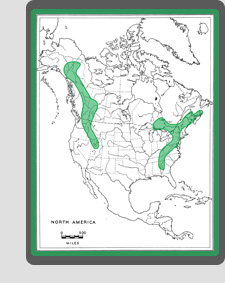
Characteristics & Similar species
Clusiodes nitidus and Clusiodes orbitalis are unlike other dark Clusiodes in that the entire costal margin of the wing (not just the anterodistal margin) is darkly-clouded. The two species can be separated as follows: in C. nitidus, the pigment along the margin of the costa is very thin and the penultimate section of A11+CuA2 is surrounded by a cloud; in C. orbitalis, no cloud is present around A11+CuA2 and the marginal cloud nearly fills the first radial cell.
Distribution
Clusiodes orbitalis has an apparently disjunct distribution in North America. In the west, it has a cordilleran range from Alaska to Utah, and in the east, it is found in the Appalachians, Atlantic highlands and mixedwood plains (although it is not yet recorded from southern Ontario). This species is expected to extend further inland and northeast, and possibly further south along the mountains to the west where it could potentially intersect the range of its closest American relative - C. nitidus (Nevada and New Mexico).